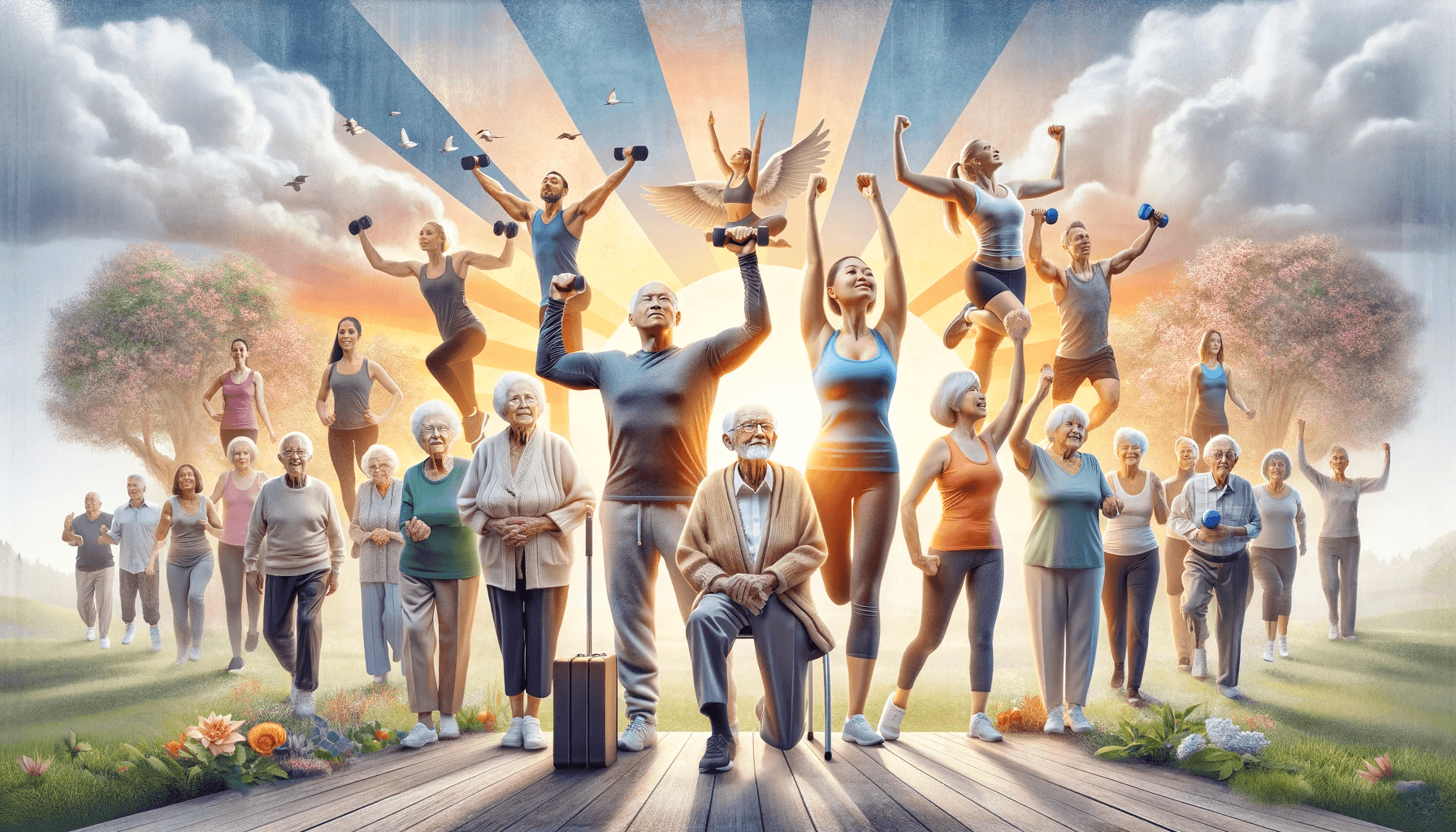Table of Contents
As we journey through life, one thing remains inevitable: the aging process. It’s a natural part of life, yet many people fear and hesitate to embrace it. But what if we could shift our perspective and see aging as an opportunity for growth, strength, and wellness? This is where the importance of fitness comes into play.
This article will explore the fear of aging and how embracing fitness can help us overcome it. We’ll delve into the physical and mental benefits of staying active as we age and discuss practical tips for maintaining a healthy and active lifestyle.
We approach aging and fitness enthusiastically and positively. We aim to inspire and motivate readers to conquer their fears, embrace aging, and prioritize their health and fitness journey.
So, if you’re ready to break free from the chains of fear and take control of your aging process, join us in this exploration of embracing the inevitable and rediscovering the power of fitness. Age is just a number, and it’s never too late to start living your best, most vibrant life. Let’s get started!
The fear of aging and its impact on fitness
Aging is often accompanied by fear and apprehension. The fear of losing strength, mobility, and independence can be overwhelming. Recognizing that these fears are normal and valid is essential, but they shouldn’t hold us back from embracing the aging process.
One common fear is the belief that our bodies become less capable of physical activity as we age. This fear can lead to a sedentary lifestyle, which only exacerbates the physical decline we fear. However, research has shown that staying active and engaging in regular exercise can slow down the aging process and help us maintain our physical abilities.
Another fear is that exercise may cause injury or exacerbate existing health conditions. While it’s essential to consult with a healthcare professional before beginning any exercise routine, it’s crucial to understand that exercise, when done correctly and with proper guidance, can be safe and beneficial for people of all ages.
Society’s obsession with youth and the pressure to maintain a youthful appearance can also contribute to the fear of aging. However, by shifting our mindset and focusing on the positive aspects of aging, we can overcome these fears and embrace the natural progression of life.
Understanding the psychology of aging
To truly embrace the aging process, it’s essential to understand the psychological aspects of aging. Our mindset and attitude towards aging significantly impact how we experience it.
One psychological concept that plays a role in our perception of aging is self-efficacy. Self-efficacy refers to our belief in our ability to succeed in specific situations or accomplish certain tasks. As we age, it’s common for self-efficacy to decline, leading to a lack of confidence in our ability to maintain an active lifestyle. However, by setting realistic goals and gradually increasing physical activity, we can rebuild our self-efficacy and regain confidence in our abilities.
Another psychological factor is the fear of losing our identity and purpose as we age. Retirement and changes in our social roles can leave us feeling lost and unsure of our place in the world. However, we can maintain a sense of purpose and fulfillment by staying active and engaging in meaningful activities, such as volunteering or pursuing hobbies.
It’s essential to recognize that aging is a unique and individual experience. Everyone’s journey is different, and embracing the inevitable means accepting and embracing our personal growth and development.
Common misconceptions about aging and fitness
As we age, we often encounter misconceptions about what is possible regarding fitness and physical activity. These misconceptions can hold us back from fully embracing the benefits of staying active.
One common misconception is that exercise is only for the young and fit. Many people believe that it’s too late to start exercising once they reach a certain age or that their bodies are no longer capable of physical activity. However, research has consistently shown that there is always time to start exercising and reap the benefits of an active lifestyle.
Another misconception is that exercise must be intense and strenuous to be effective. While vigorous exercise certainly has its benefits, even moderate-intensity activities like walking, swimming, or gardening can significantly improve our health and well-being.
Additionally, some people believe that strength training is only for bodybuilders or athletes. However, strength training is essential for maintaining muscle mass and bone density as we age. It can help prevent falls and fractures and improve overall physical function.
By debunking these misconceptions and challenging societal norms, we can empower ourselves to embrace the possibilities of fitness at any age.
Embracing the physical changes of aging
One of the challenges of aging is the physical changes that occur in our bodies. It’s important to acknowledge and embrace these changes rather than fight against them.
One significant change is the loss of muscle mass and strength, known as sarcopenia. As we age, our bodies naturally lose muscle, which can decrease strength and mobility. However, we can slow down this muscle loss and maintain our physical capabilities by engaging in regular strength training exercises.
Another physical change is the loss of flexibility and joint mobility. Stiffness and a decrease in range of motion can make everyday tasks more challenging. Incorporating stretching and flexibility exercises into our routine can help improve joint mobility and maintain flexibility.
It’s also important to recognize that our bodies may take longer to recover from exercise as we age. This doesn’t mean we should avoid physical activity altogether; instead, we should listen to our bodies and adjust our routines accordingly. Rest and recovery are as important as exercise, especially as we age.
By embracing these physical changes as a natural part of the aging process, we can focus on what our bodies are capable of and find joy in staying active.
Importance of maintaining an active lifestyle as you age
Staying active as we age is crucial for maintaining physical and mental well-being. Regular exercise offers many benefits that can significantly improve our quality of life.
One of the most apparent benefits of exercise is improved physical health. Regular physical activity can help reduce the risk of chronic conditions such as heart disease, diabetes, and certain types of cancer. It can also help manage weight, improve cardiovascular health, and strengthen bones and muscles.
Exercise also plays a vital role in maintaining cognitive function and mental health. Research has shown that staying active can help improve memory, boost mood, reduce symptoms of anxiety and depression, and enhance overall cognitive abilities.
Furthermore, regular exercise can improve sleep quality, increase energy levels, and enhance overall vitality. It can also help manage stress and promote well-being and self-confidence.
By committing to an active lifestyle, we can experience these numerous benefits and age gracefully with strength, vitality, and happiness.
Overcoming barriers to fitness in older age
While the benefits of exercise are undeniable, various barriers can prevent older adults from maintaining an active lifestyle. It’s essential to address and overcome these barriers to ensure long-term success and enjoyment in fitness.
One common barrier is the need for more time. Many older adults juggle responsibilities such as work, caregiving, and social engagements. However, we can overcome this barrier by prioritizing physical activity and finding creative ways to incorporate exercise into our daily routines. Even short bursts of activity throughout the day can add up and make a significant difference in our health.
Another barrier is a need for more motivation or interest. It’s normal to have days when we don’t feel like exercising or lack the motivation to get moving. However, by finding activities that we enjoy and align with our interests and preferences, we can stay motivated and committed to our fitness journey.
Financial constraints can also be a barrier to fitness, as gym memberships and personal training sessions can be expensive. However, many affordable or accessible options are available, such as walking or jogging outdoors, using online workout videos, or joining community fitness programs.
Lastly, health concerns or chronic conditions can make exercise daunting or unsafe. It’s crucial to consult with a healthcare professional before starting any exercise routine, as they can provide guidance and recommendations based on our specific needs and limitations.
Identifying and addressing these barriers can create a sustainable and enjoyable fitness routine that fits our unique circumstances.
Finding the right exercise routine for your age and fitness level
When it comes to exercise, there is no one-size-fits-all approach. The right exercise routine will vary depending on age, fitness level, and individual goals. We must find activities that we enjoy and suit our specific needs.
For older adults, a well-rounded exercise routine should include a combination of cardiovascular, strength, and flexibility exercises. Cardiovascular exercises like walking, cycling, or swimming help improve heart health and endurance.
Strength training exercises, such as lifting weights or using resistance bands, are essential for maintaining muscle mass and bone density. It’s important to start with lighter weights or resistance and gradually increase the intensity as our strength improves.
Flexibility exercises, such as yoga or Pilates, help improve joint mobility and maintain range of motion. These exercises can also promote relaxation and reduce stiffness.
It’s essential to listen to our bodies and make modifications as needed. If a particular exercise causes pain or discomfort, it’s crucial to stop and consult with a healthcare professional.
Incorporating strength training and flexibility exercises
Strength training and flexibility exercises play a significant role in maintaining our physical capabilities as we age. These forms of exercise offer numerous benefits and can be adapted to suit our individual needs and abilities.
Strength training exercises help build muscle and improve overall physical function. They can be performed using various equipment, such as dumbbells, resistance bands, or weight machines. It’s essential to start with lighter weights and gradually increase the intensity as our strength improves.
Flexibility exercises help improve joint mobility and maintain range of motion. They can include stretching exercises, yoga poses, or Pilates movements. It’s crucial to warm up before engaging in flexibility exercises to prevent injury and increase effectiveness.
Incorporating strength training and flexibility exercises into our routine can help us maintain balance, stability, and physical independence as we age. It’s essential to consult with a fitness professional or physical therapist to ensure proper form and technique.
Seeking support and motivation in your fitness journey
Embarking on a fitness journey can feel overwhelming, especially when facing the fear of aging. It’s important to seek support and motivation to stay on track and overcome any challenges that may arise.
One way to find support is by joining fitness classes or group activities. Exercising with others can provide accountability, motivation, and a sense of community. Many community centers, gyms, and senior centers offer group exercise programs specifically designed for older adults.
Another option is to find a workout buddy or partner. Exercising with a friend or family member can make workouts more enjoyable and help us stay committed to our fitness goals.
If joining a group or finding a workout buddy isn’t feasible, online communities and forums allow us to connect with like-minded individuals on a similar fitness journey. These communities can provide support, motivation, and a platform to share experiences and tips.
Lastly, it’s essential to celebrate small victories along the way. Progress may be slow, but every step forward is worth celebrating. We can stay motivated and inspired to continue our fitness journey by acknowledging and celebrating our achievements.
Embracing the benefits of aging and fitness – improved health, confidence, and longevity
By embracing the inevitable aging process and prioritizing our health and fitness, we can experience many benefits that extend far beyond physical well-being.
Regular exercise can improve overall health, reduce the risk of chronic diseases, and increase longevity. It can also boost our immune system, improve sleep quality, and enhance cognitive function.
Engaging in physical activity can also boost our confidence and self-esteem. As we challenge ourselves and achieve fitness goals, we prove we can do more than we initially believed. This newfound confidence can spill over into other areas of our lives, leading to a more fulfilling and vibrant existence.
Furthermore, staying active can help us maintain our independence and quality of life as we age. By prioritizing our health and fitness, we can continue to enjoy the activities we love, spend time with loved ones, and engage in new experiences.
In conclusion, embracing the inevitable aging process and prioritizing our health and fitness is essential for living a vibrant and fulfilling life. By understanding the fears and misconceptions associated with aging, finding the right exercise routine, seeking support, and celebrating our achievements, we can conquer our fears and embrace the power of fitness at any age. Age is just a number, and with a positive mindset and a commitment to our well-being, we can age gracefully and confidently. Let’s embrace the inevitable and embark on a journey of strength, wellness, and self-discovery.




